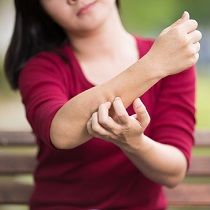News
Article
Increased Prurigo Nodularis Severity Linked to Increased Disease Burden
Author(s):
This web-based research is the first conducted to assess the burden of disease and treatment satisfaction among those in Japan with PN.

Prurigo nodularis (PN) patients in Japan report increases in their disease burden and diminished satisfaction in their treatment, according to new findings, even when guideline-recommended therapies are implemented.1
These results were drawn from an online questionnaire of adult individuals with diagnoses of PN in Japan. The analysis was conducted given that both the range and the degree of the PN burden and its effect on satisfaction ratings had not been previously investigated.
This research was led by Hiroyuki Murota, from the Department of Dermatology at Nagasaki University School of Medical Sciences in Nagasaki, Japan. Murota and colleagues noted that prior research in Europe looking at the greatest self-reported associations with disease burden among PN patients.2
“In this study, we conducted an online questionnaire of adult patients with PN in Japan who were diagnosed and treated by dermatologists, to assess their current disease burden and treatment satisfaction,” Murota and colleagues wrote.
Background and Findings
The investigators in Japan conducted their web-based, observational researcj between the months of April and May 2022, recruiting participants for the study who had been given diagnoses of PN and recruiting their treating dermatologists. The market research company Plamed Inc. was used to include dermatologists and it ended up finding around 53,000 registered physicians, with eligible patients also being referred by these clinicians.
Each and every one of the subjects’ responses were anonymized by the research team before later being assessed by the group Social Survey Research Information Co., Ltd found in Tokyo. The team’s work which was explored here presented the survey results for individuals with PN, and they noted that the dermatologist survey results are planned to be published separately.
The investigators asked individuals who were aged >20 years and that had clinician-diagnosed PN living in the country Japan to participate. The research team asked that the participants have a disease duration of ≥3 months as well as a medical institution meeting for their PN in the prior half-year.
Several different tools for assessment were used by the team, including the Dermatology Life Quality Index (DLQI), Patient Health Questionnaire 9 (PHQ-9), Numerical Rating Scales (NRS) for burning sensation, pruritus, and sleep disturbances, Global Questions (GQ), Work Productivity and Activity Impairment (WPAI), Short-Form-8 (SF-8) Health Survey, and Treatment Satisfaction Questionnaire for Medication–9 (TSQM-9), to look at disease burden and patient treatment satisfaction in subjects.
The investigators’ research ended up involving 97 participants, with the population being 55.7% male, having a median age of 51 years, and a median PN duration of 36 months. The subjects’ GQ scores were divided up into 35.1% with cases considered mild, 50.5% considered moderate, and 14.4% considered severe.
The research team notably found that disease severity was shown to be correlated with subjects’ increased disease burden, and this was clear among the worsened pruritus NRS scores and due to the impaired quality of life (losses in work productivity, PHQ-9, DLQI, WPAI presenteeism,, and activity impairment scores).
Additionally, the investigators reported that those with cases of comorbid atopic dermatitis (AD) were found to have experienced more intense instances of pruritus. TSQM-9 scores for convenience, levels of effectiveness, and global satisfaction were shown to be 54.7 ± 18.1%, 62.4 ± 15.2%, and 57.4 ± 15.9%, respectively.
Subjects placed on intensive guideline-directed treatment—involving topical corticosteroids and systemic oral corticosteroids or cyclosporine—were shown to have reported having lower TSQM-9 scores. This, the investigators determined, showed there had been an unmet need for more efficacious PN treatments.
“Increased disease severity and increased treatment intensity appeared to be associated with reduced treatment satisfaction,” they wrote. “More effective treatment options are needed to reduce disease burden and improve treatment satisfaction among patients with currently intractable severe PN.”
References
- Murota, H, Arima, K, Yoshida, T, Fujita, H. Disease burden and treatment satisfaction in patients with prurigo nodularis in Japan. J Dermatol. 2023; 00: 1–11. https://doi.org/10.1111/1346-8138.17045.
- Pereira MP, Zeidler C, Wallengren J, Halvorsen JA, Weisshaar E, Garcovich S, et al. Chronic nodular prurigo: a European cross-sectional study of patient perspectives on therapeutic goals and satisfaction. Acta Derm Venereol. 2021; 101:adv00403.





